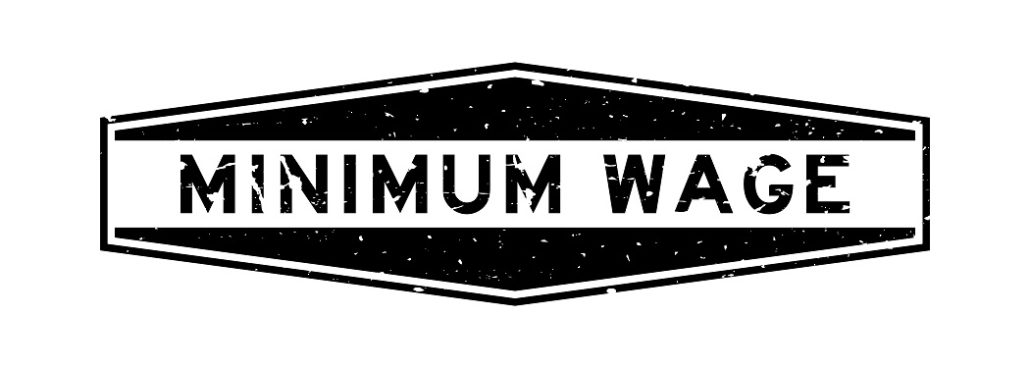State and Federal Minimum Wage in the US 2022 (with 2023 Increases)
5 min read
On this page
Minimum wage in the US is a hot button topic because of its impact on everyday life in America.
The US minimum wage law has protected workers for decades. Congress created the law to meet public demand for fair compensation for workers. Over the years, the Congress has modified the law several times to include more workers and to raise the minimum wage rate.

What is the minimum wage law?
The minimum wage law establishes that employers across the country must pay their employees a minimum hourly rate.
Each state in the country has its own minimum wage rate. An employer must pay the higher of the two rates to its employees.
In short, workers must be paid the federal minimum wage but could receive higher hourly rates depending on the state they reside in.
Current Federal and State minimum wage rates in the US
The current federal minimum wage for covered employees is $7.25 per hour – it hasn’t been raised since 2009.
Minimum wage in each sate:
The following table shows minimum wage rate for each state in the United States.
State | Minimum Wage in 2022 | Expected Minimum Wage in 2023 |
Alabama | No State Minimum | No change. |
Alaska | $10.30 | No change. |
Arizona | $12.80 | No change. |
Arkansas | $11.00 | No change. |
California | $15.00 | The $15 minimum will apply to all employers. |
Colorado | $12.50 | No change. |
Connecticut | $14.00 | $15 effective 6/01/2023 |
Delaware | $10.50 | $11.75 |
Washington, D.C. | $15.20 | No change. |
Florida | $11.00 | $12.00 effective 9/30/2023 |
Georgia | $5.15 | No change. |
Hawaii | $10.10 | No change. |
Idaho | $7.25 | No change. |
Illinois | $12.00 | $13.00 |
Indiana | $7.25 | No change. |
Iowa | $7.25 | No change. |
Kansas | $7.25 | No change. |
Kentucky | $7.25 | No change. |
Louisiana | $7.25 | No change. |
Maine | $12.70 | No change. |
Maryland | $12.50 | No change. |
Massachusetts | $14.20 | $15.00 |
Michigan | $9.87 | $10.10 |
Minnesota | $10.30 | Annual increases will begin on January 1, 2023. |
Mississippi | $7.25 | No change. |
Missouri | $11.10 | $12.00 |
Montana | $9.20 | Annual increases will begin on January 1, 2023. |
Nebraska | $9.00 | No change. |
Nevada | $9.50 | $11.25 |
New Hampshire | $7.25 | No change. |
New Jersey | $13.00 | $14 per hour for businesses with under six employees. |
New Mexico | $11.50 | $12.00 |
New York | $13.20 and $15 for fast food | No change |
North Carolina | $7.25 | No change. |
Ohio | $9.30 | Annual increases will begin on January 1, 2023. |
Oklahoma | $7.25 | No change. |
Oregon | $13.50 | Annual increases will begin on January 1, 2023. |
Pennsylvania | $7.25 | No change. |
Rhode Island | $12.20 | $13.00 |
South Carolina | $7.25 | No change. |
South Dakota | $9.95 | No change. |
Tennessee | $7.25 | No change. |
Texas | $7.25 | No change. |
Utah | $7.25 | No change. |
Vermont | $12.50 | Annual increases will begin on January 1, 2023. |
Virginia | $11.00 | $12.00 |
Washington | $14.40 | No change. |
West Virginia | $8.75 | No change. |
Wisconsin | $7.25 | No change. |
Wyoming | $5.15 | No change. |
A brief history of minimum wage law in the United States of America
Congress passed the Fair Labor Standards Act (FLSA) in 1938. This was a big moment in the history of the labor movement. For the first time in history, the federal government set a minimum wage and established rules that employees are entitled to a certain amount of pay for their work.
Since 1938, the U.S. federal minimum wage has been raised 22 times.
But did you know that the US was not the first country to legislate the minimum wage?
In 1831, silk industry workers in Lyon, France, went on strike. They were protesting because they were not earning enough money to meet their basic needs despite working long hours.
The walkout was unsuccessful, but the idea of a minimum wage was firmly put in motion. The message resonated with many across the world.
The push for a minimum wage actually began in New Zealand. In 1894, New Zealand enacted the Industrial Conciliation and Arbitration Act.
It was the first nation in the world in which the government set a minimum wage for workers. The law also banned worker strikes and lockouts by employers. Lockouts are acts of withholding employment to gain leverage in labor disputes.
In 1898, Samuel Gompers, the founding president of the American Federation of Labor, published an article titled “A Minimum Living Wage.” In it, he argued adamantly that employees must be paid at least enough to meet their basic needs. In addition, he stated that there should be a legal minimum when it came to hourly rates.
In 1912, Massachusetts enacted the first minimum wage in America. Some other states followed suit.
But in 1923, the U.S. Supreme Court ruled that imposing a minimum wage violated employers’ and workers’ liberty of contract rights under the Fifth Amendment. The ruling invalidated states’ minimum wage laws and limited them to offering advice to employers who could set their own standards.
Franklin D. Roosevelt was eager to improve the lives of workers suffering during the Great Depression. So, he convinced Congress to enact the National Industrial Recovery Act in 1933 (NIRA).
The NIRA then suspended the antitrust restrictions and allowed industries to enforce their fair-trade codes, raising hourly rates. The NIRA also abolished child labor.
The cotton industry was the first to enact this code, which set a minimum weekly wage of $13 in northern states and $12 in southern states.
After achieving this monumental goal, Roosevelt pushed employers to sign the President’s Reemployment Agreement. It was a pledge to offer $12 to $15 weekly in exchange for 35 to 40 hours of labor. Employers who agreed got to display the blue eagle badge with the motto “We Do Our Part.”
In 1935, the Schechter Poultry Corp v. United Supreme Court case struck down the industry codes that had been established.
As a result, the minimum wage became a big in the 1936 presidential election. The incumbent at the time, Franklin D. Roosevelt, promised a new push for progress as the majority of Americans wanted a minimum wage.
1937 was a year of notable change: The Supreme Court narrowly upheld Washington state’s minimum wage law when Justice Owen Roberts unexpectedly sided with the court’s four-member liberal minority.
The West Coast Hotel Co. v. Parrish case involved a former chambermaid who sued a hotel for $216.19 in back wages—she claimed these were owed to her under United States law.
This decision reversed the judicial trend. It established that minimum wage laws did not violate the Constitution. It’s referred to as the “big switch” by historians.
In 1938, after much legislative struggle, Congress passed the Fair Labor Standards Act, which established a federal minimum wage of $0.25 per hour. The bill was then signed into law by President Roosevelt.
Initially, the legislation had called for a $0.40-per-hour minimum, but it had to be scaled back to get the support of members of Congress from southern states.
In 1949, Congress raised the federal minimum wage to 75 cents. This would be the first of numerous increases enacted over the next six decades.
Congress amended the FLSA to cover more workers and allow retail and service businesses to hire full-time students at 15% below the minimum wage in 1961.
In 1963, President Kennedy signed the Equal Pay Act into law, amending the Fair Labor Standards Act. It specified that workers covered by the federal minimum wage requirement were entitled to equal pay for the same job, regardless of gender. The Associated Press reported that 8 million women were covered among the 27 million U.S. workers.
By 1968, the federal minimum wage had increased significantly to $1.60 per hour, equivalent to $11.53 in 2019. Higher wages meant more purchasing power for workers.
With earnings closer to living costs, poverty was often equated with unemployment, since workers were finally bringing in enough money to make ends meet.
After 1968, inflation rose, but the minimum wage did not keep up with the increased cost of living.
In 1974, Congress broadened the minimum wage law to cover all non-supervisory government employees.
In 1989, Congress updated the FLSA to only apply to businesses with at least $500,000 in annual revenue. It also mandated that smaller retail companies were subject to the law during any workweek when they engaged in interstate commerce or produced goods that would be sold in other states.
By 2009, the federal minimum wage had risen to $7.25 per hour due to the legislation passed two years earlier.
In 2016, New York and California legislators passed laws raising their minimum wages to $15 per hour.
By 2019, twenty-nine states and Washington, D.C. maintained higher minimum wages than the federal standard. Eight states automatically increased their minimum hourly rates to keep up with the cost of living.
Who is covered by the federal minimum wage law?
The federal minimum wage law applies to U.S. employees working for organizations with annual sales of at least $500,000. In addition, it includes workers in hospitals, nursing homes, schools, government agencies, and those involved in interstate commerce in their jobs.
Wages and overtime pay
Employers who permit their employees to work overtime—more than 40 hours per week—are generally required to provide them with premium pay. As a result, all nonexempt employees must receive overtime pay for working extra hours under United States law.
Exempt vs. Nonexempt employees
Exempt employees are not eligible for minimum wage, overtime regulations, and other protections. Typically, these employees adhere to a salary model of work. Exempt roles are not required to comply with FLSA standards. Employees are expected to put in as many hours as needed for the agreed-upon amount of money.
Nonexempt employees are eligible for FLSA requirements, including the federal minimum wage and overtime pay if they work more than forty hours per week. Most nonexempt roles follow a rate-per-hour model. Still, it is common for these workers to earn a salary or a commission instead.
The projected federal minimum wage in 2023
The Department of Labor has announced that with the Executive Order 14026 minimum wage for workers working on federal contracts will increase to $16.20 per hour, beginning on January 1, 2023. Many states are also increasing their required hourly rate.
The minimum wage affects whether families across the country can put food on the table every week, so it is an integral element of American society. It’s essential to keep track of the various changes that might affect an upcoming paycheck.
